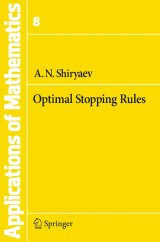Details

Optimal Stopping Rules
Stochastic Modelling and Applied Probability, Band 8
|
90,94 € |
|
| Verlag: | Springer |
| Format: | |
| Veröffentl.: | 23.09.2007 |
| ISBN/EAN: | 9783540740117 |
| Sprache: | englisch |
| Anzahl Seiten: | 220 |
Dieses eBook enthält ein Wasserzeichen.
Beschreibungen
Along with conventional problems of statistics and probability, the - vestigation of problems occurring in what is now referred to as stochastic theory of optimal control also started in the 1940s and 1950s. One of the most advanced aspects of this theory is the theory of optimal stopping rules, the development of which was considerably stimulated by A. Wald, whose Sequential ~nal~sis' was published in 1947. In contrast to the classical methods of mathematical statistics, according to which the number of observations is fixed in advance, the methods of sequential analysis are characterized by the fact that the time at which the observations are terminated (stopping time) is random and is defined by the observer based on the data observed. A. Wald showed the advantage of sequential methods in the problem of testing (from independent obser- tions) two simple hypotheses. He proved that such methods yield on the average a smaller number of observations than any other method using fixed sample size (and the same probabilities of wrong decisions). Furth- more, Wald described a specific sequential procedure based on his sequ- tial probability ratio criterion which proved to be optimal in the class of all sequential methods. By the sequential method, as applied to the problem of testing two simple hypotheses, we mean a rule according to which the time at which the observations are terminated is prescribed as well as the terminal decision as to which of the two hypotheses is true.
Random Processes: Markov Times.- Optimal Stopping of Markov Sequences.- Optimal Stopping of Markov Processes.- Some Applications to Problems of Mathematical Statistics.
<P>Although three decades have passed since first publication of this book reprinted now as a result of popular demand, the content remains up-to-date and interesting for many researchers as is shown by the many references to it in current publications.</P>
<P>The "ground floor" of Optimal Stopping Theory was constructed by A.Wald in his sequential analysis in connection with the testing of statistical hypotheses by non-traditional (sequential) methods.</P>
<P>It was later discovered that these methods have, in idea, a close connection to the general theory of stochastic optimization for random processes.</P>
<P>The area of application of the Optimal Stopping Theory is very broad. It is sufficient at this point to emphasise that its methods are well tailored to the study of American (-type) options (in mathematics of finance and financial engineering), where a buyer has the freedom to exercise an option at any stopping time.</P>
<P></P>
<P>In this book, the general theory of the construction of optimal stopping policies is developed for the case of Markov processes in discrete and continuous time. </P>
<P>One chapter is devoted specially to the applications that address problems of the testing of statistical hypotheses, and quickest detection of the time of change of the probability characteristics of the observable processes.</P>
<P>The author, A.N.Shiryaev, is one of the leading experts of the field and gives an authoritative treatment of a subject that, 30 years after original publication of this book, is proving increasingly important.</P>
<P>The "ground floor" of Optimal Stopping Theory was constructed by A.Wald in his sequential analysis in connection with the testing of statistical hypotheses by non-traditional (sequential) methods.</P>
<P>It was later discovered that these methods have, in idea, a close connection to the general theory of stochastic optimization for random processes.</P>
<P>The area of application of the Optimal Stopping Theory is very broad. It is sufficient at this point to emphasise that its methods are well tailored to the study of American (-type) options (in mathematics of finance and financial engineering), where a buyer has the freedom to exercise an option at any stopping time.</P>
<P></P>
<P>In this book, the general theory of the construction of optimal stopping policies is developed for the case of Markov processes in discrete and continuous time. </P>
<P>One chapter is devoted specially to the applications that address problems of the testing of statistical hypotheses, and quickest detection of the time of change of the probability characteristics of the observable processes.</P>
<P>The author, A.N.Shiryaev, is one of the leading experts of the field and gives an authoritative treatment of a subject that, 30 years after original publication of this book, is proving increasingly important.</P>
Although three decades have passed since first publication of this book reprinted now as a result of popular demand, the content remains up-to-date and interesting for many researchers as is shown by the many references to it in current publications The area of application of the optimal stopping theory is very broad Includes supplementary material: sn.pub/extras
<P>Although three decades have passed since first publication of this book - reprinted now as a result of popular demand - the content remains up-to-date and interesting for many researchers as is shown by the frequent references to it in current publications. The area of application of the Optimal Stopping Theory is very broad. In this book, the general theory of the construction of optimal stopping policies is developed for the case of Markov processes in discrete and continuous time. One chapter is devoted specially to the applications that address problems of the testing of statistical hypotheses, and quickest detection of the time of change of the probability characteristics of the observable processes. The author is one of the leading experts of the field and gives an authoritative treatment of a subject that, 30 years after original publication of this book, is proving increasingly important.</P>

















